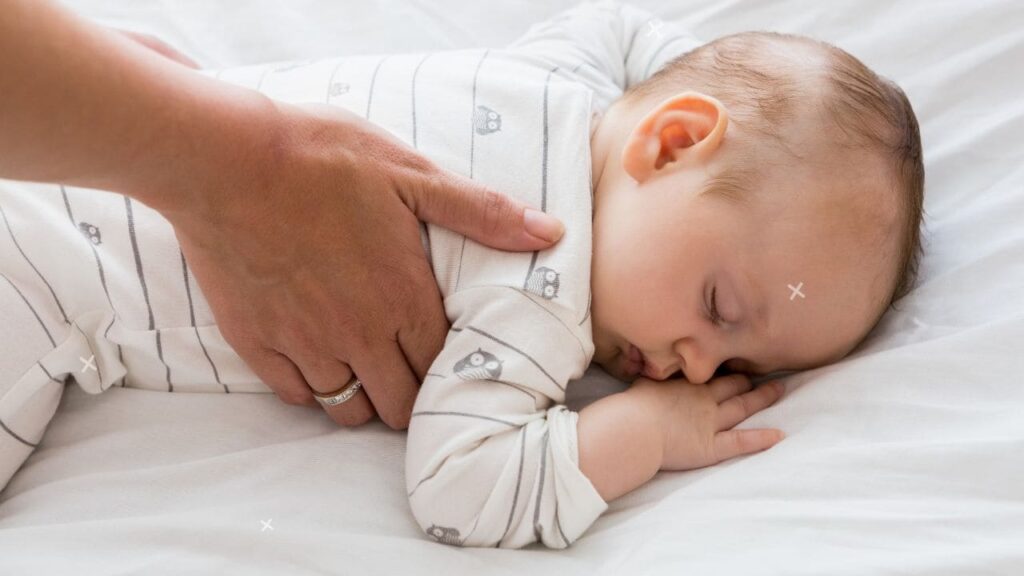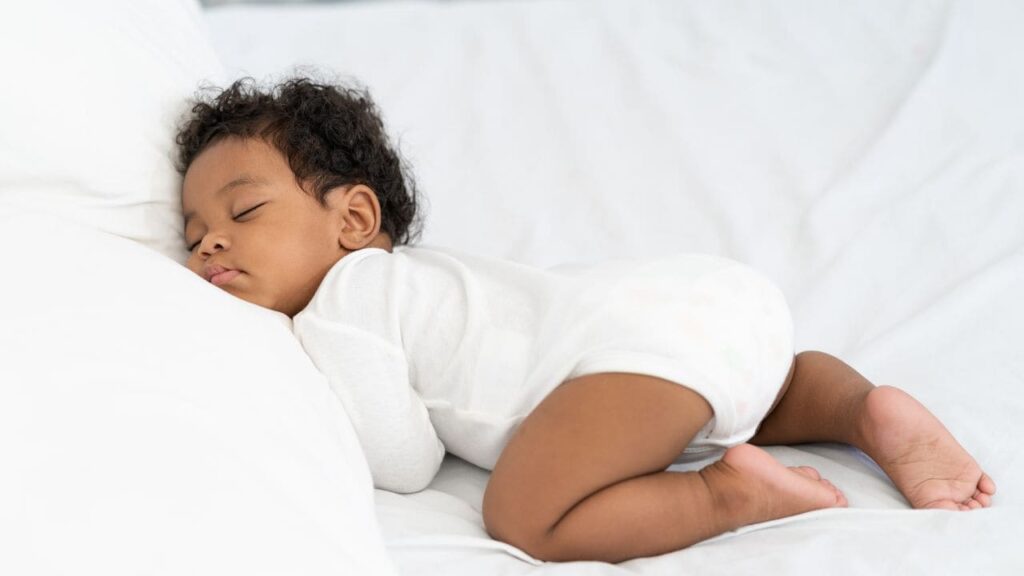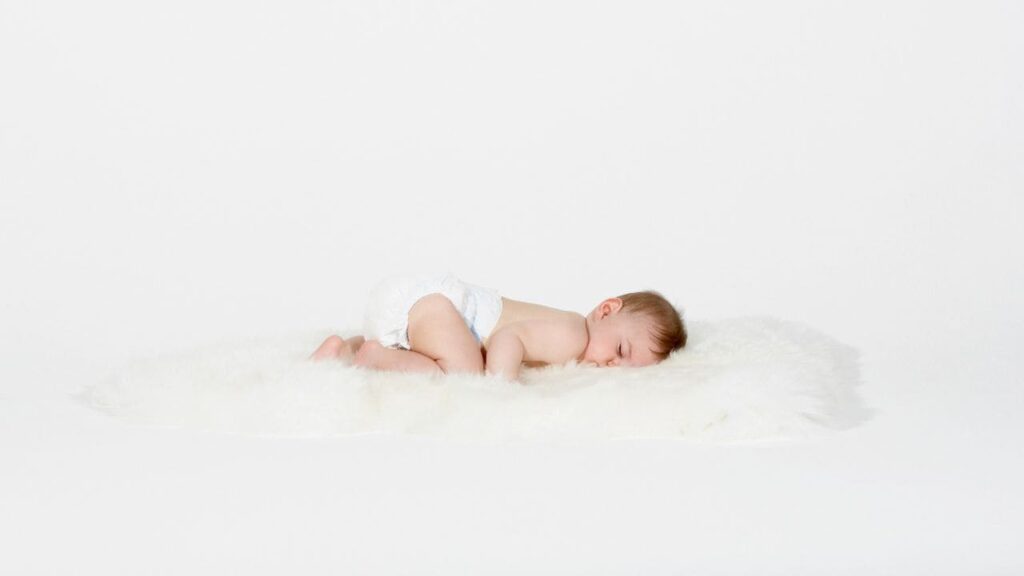As a parent staring lovingly at your sleeping baby, you may notice them snoozing in some of the silliest and most endearing positions. One of the most common is with their little butt raised high in the air. I know when I first spotted my daughter sleeping in her crib looking like a tiny downhill skier preparing for a black diamond run, I had questions.
Why do babies sleep with their butt in the air? Is it safe? What does it indicate about their health and development? I was puzzled, so I decided to do some digging. What I uncovered surprised me and revealed so much fascinating information about the miracle that is infant sleep behavior.
| Sleep Position | What it Indicates | Tips for Parents |
|---|---|---|
| Butt in the air | Healthy primitive reflexes, motor development | Allow baby room to stretch legs up, don’t overswaddle |
| Side sleeping | Improving strength/coordination if alternating sides | Reposition if favoring one flat spot |
| Stomach sleeping | Avoid until approx 6 months due to suffocation risk | Wait for head control and rolling ability |
It All Starts With Primitive Reflexes
In the early months after birth, babies are driven purely by instinct and reflexes programmed into them from their time in the womb. These reflexes are involuntary motions that help them adapt to their brand new world. One of these is called the Moro or startle reflex. When startled, a baby will immediately throw back their head, extend out their limbs, then quickly pull them back in.
Sleeping with their butt in the air mimics this startle position. It allows their still developing motor system to fully stretch out then curl back up into a ball. This flexing motion soothes and relaxes them, preparing their body for much needed rest. It’s almost like when we adults stretch out our arms and extend our spines before settling in for bed. Their little booties pointed upward is just their version!
As your baby grows, these primitive reflexes will integrate and their infant sleep patterns will likely become more varied. But in the early months, the froggy style snooze is incredibly common.
Sleep Tip: Swaddling can amplify feelings of security and comfort, encouraging restful sleep. But make sure to leave their lower body unswaddled if your baby is a butt-in-the-air sleeper!

The Frog Pose Aligns Their Spine
Another related reason babies sleep in this funny butt-in-the-air position is it allows their spine to straighten out and elongates their core. You see, infants tend to curl up because of their chubby torso and low muscle tone. Their heavy heads tilting forward puts strain on their still developing neck and back muscles.
But when they flip their legs up over their torso into a frog-like pose, it brings their spine into alignment. This relieves any pressure and helps strengthen core muscles so they can eventually lift their head independently. It also prevents the dreaded flat head syndrome that affects many young babies. So you can think of it as the equivalent of us doing yoga before bed!
Sleep Tip: If baby sleeps butt up rotated mostly to one side, try repositioning their head when putting them down so they turn the opposite way next sleep. This will prevent uneven flat spots.
Let Me Vent! Air Circulation is Key
Sleep is a time when our bodies cool off and reset their baseline temperature through the night. For little ones, a raised booty helps release excess heat from their groin and back, preventing overheating. The exposure allows more airflow around areas prone to heat rashes.
And babies aren’t born yet knowing how to toss, turn, and kick off blankets if they get sweaty. So sleeping in the air butt position helps naturally circulate air and regulate their temperature all night long. As an added bonus, the upward tilted position opens up nasal airways, which leads to..
Sweet Dreams In No Time: Gravity Helps Digestion
Trying to sleep soundly on a stomach full of milk is no easy feat! But luckily for babies, snoozing butt in the skies aids digestion and prevents uncomfortable gas bubbles or reflux from forming. Keeping their torso slightly upright makes it easier for the stomach to break down milk and food. It also stops acid from rising up into the esophagus which can cause irritation.
And as gravity pulls food downward, it prevents spit up messes. This means more milk stays down supplying vital nutrients for growth and less ends up soaked into crib sheets! It’s comforting as a parent to see baby sleep this way knowing their tiny tummy will quickly feel relief. Over time as their muscles strengthen and digestion system matures, the butt boosted position becomes less necessary.
Sleep Tip: Use light, breathable cotton jammies to prevent overheating and make sure baby’s head remains uncovered.

Flexing Their Strength: Muscle Development Milestones
In the early months, infants have essentially no control over their muscle movement. They can’t voluntarily push up, roll over, or adjust positions without assistance. However, sleep is when interesting changes start to happen! They begin to automatically move into poses that progressively build strength.
The curled frog position with their legs tucked in tight not only aids breathing and spinal alignment but also enables muscle flexion and stretching. This movement strengthens their legs in preparation for rolling over, sitting upright, crawling, and eventually walking! It also enhances motor neuron development which controls coordinated movement.
Over time you’ll notice your sturdy little frog start experimenting with sideways sleeping, stomach down snoozing, or flipping completely upright as they gain control of their muscles. Of course that adorable butt might stay pointed skyward awhile longer! But know that this funny butt-in-the-air sleep position indicates healthy physical growth.
Developmental Milestones Timeline
Understanding normal strength and coordination milestones will give insight into why your baby progresses through positions:
2-3 Months – Head Control, tracking objects with eyes
4 Months – Rolling front to back/back to front, bearing weight on legs
6 Months – Sitting independently without support
8-10 Months – Crawling sequence, pulling self to stand
10-12 Months – Cruising (side stepping) along furniture, first solo steps
| Age | Disorder | Signs to Watch For |
|---|---|---|
| 0-6 months | Hip dysplasia | Legs stay in tight frog position |
| 0-6 months | Low muscle tone | Difficulty moving head/limbs |
| All ages | Spinal issues | Favoring one sided, asymmetrical poses |
| All ages | Neuro conditions | Lack of position progression |

Contributing Factors and Health Considerations
A baby’s tendency to sleep with their bottom raised high can relate to multiple contributing factors and health considerations in these early months:
Positional Plagiocephaly (Flat Head Syndrome): The frog-like pose with baby’s torso curled inward can accompany flattening on one side of the skull. Always alternating direction they face while sleeping can prevent uneven pressure.
Acid Reflux and GERD: Keeping the stomach slightly elevated eases digestion and allows gravity to keep acid from rising up. Discuss symptoms like arching of back or irritability during feeding with your pediatrician.
Brain and Neurological Development: The movement and vestibular stimulation of varied sleep positions activates crucial connections between nerves and brain. Talk to your doctor if you notice any developmental delays.
Sensory Processing Issues: Babies who struggle processing sensory input may find butt-raised sleeping calming. If overstimulated easily, discuss occupational therapy options.
The Connection to Colic: Pulled-up legs can relieve symptoms of infant colic like gas pains or abdominal discomfort. Track episodes and eliminations to identify triggers.
Immune System Impacts: Diverse sleep movements build core strength needed to clear respiratory secretions that spread infection. Watch for patterns of frequent illness.
Influence of Swaddling: While swaddling is calming, allowing leg mobility enables healthy hip and spine development. Adapt wrap styles as baby grows.
When to Worry About Sleep Positions
While the butt in the air sleep style is incredibly common and nothing to worry about, it’s still important to monitor changes. If, by 6 months of age, your baby shows no change whatsoever in sleep position, it may signify an underlying condition hampering development.
Specifically, take note if baby resists moving out of one fixed pose, always keeps their arms and legs in tight against their body, or never attempts to roll. Consult your pediatrician promptly if you observe any of these red flags for early intervention assessment.
Outside of musculoskeletal issues, a consistently elevated hindquarters well into the toddler years could indicate breathing trouble or severe reflux requiring evaluation. Otherwise, enjoy your baby’s build-in kickstand while it lasts!
Supporting Healthy Sleep Habits
As your tiny sleeper develops, you can promote healthy sleep habits through thoughtful care and environmental adjustments:
• Allow baby to find their own comfy positions – Don’t overswaddle or forcefully reposition them if butt is in the air. Respect their natural sleep cues and patterns!
• Prep a safe area for rolling/moving – Remove loose bedding, keep sleep surface bare beyond fitted sheet, position crib away from cords/blinds.
• Encourage exploratory daytime naps – Allow baby freedom to test out new poses, contours of mattress during snoozes.
• Extend overnight sleep efficiency – Employ white noise, blackout curtains, calming pre-bedtime routine to avoid overstimulation.
Trust in your baby’s instincts to drift off exactly as needed for healthy growth. The charming rearview display is temporary afterall! So soak up that little bootied pose while you can.
| Best Practices for Infant Sleep Spaces | Specific Recommendations |
|---|---|
| Mattress/Crib Fit | Snug – no excessive space between edge and sides |
| Sheet Material | Light, breathable cotton recommended |
| Mattress Firmness | Non-compressible; does not indent when pressed |
| Room Ventilation | Open air flow, ceiling fan on low |
| Room Temperature | Comfortable between 68-72 Fahrenheit |

Preparing Baby’s Sleep Environment
Setting up the crib/sleep area properly allows your baby to continuetheir natural movements that aid healthy development:
- Allow leg room for froggy poses – position crib against wall to leave space for air raised hindquarters.
- Choose thin, firm mattress that supports mobility as muscles strengthen. Soft surfaces make movements more difficult.
- Ensure mesh liner or breathable crib bumper to optimize airflow around baby’s body.
- Favor light, cotton jammies and sheets to prevent overheating and irritation.
- Position crib/bassinet properly so you can access baby for soothing while also not looming over them.
These tips would enhance the section on healthy sleep habits with specifics on adjusting their sleep space.
Take Baby’s Butt Boosted Sleep Style in Stride!
When you spot your roly poly bundle of joy snoozing with their bottom elevated triumphantly sky high, take comfort. This delightful sleep position indicates incredible instinctive ability tailored perfectly for infant development.
Through long nighttime stretches, your baby strengthens their muscles, realigns their spine, aids digestion, and regulates their body temperature. All with just some lifted legs and a pert behind!
Next time your infant’s booty catches your loving parental glance, smile knowing this period is fleeting. Soon they’ll outgrow the reflex and graduate to more advanced sleep skills like rolling, crawling, and standing. But in the early days, that little uptilted rear is absolutely perfect.
So enjoy your baby’s quirky butt-in-the-air sleep style while it lasts! And don’t forget to snap some photos capturing those bowlegged froggy jammies in action. Someday when that butt is bigger, those pics will sure make ‘em laugh!
FAQ – Why Do Babies Sleep With Their Butt in the Air?
How long will my baby continue sleeping with their butt in the air?
Most infants sleep in the butt-raised position for 2-3 months as their primitive reflexes integrate and muscle control develops. By 6 months when most babies can roll over easily, the legs-in-air sleep style starts fading although some continue it longer. Discuss any concerns with your pediatrician.
Could the aerial booty position be a sign of gastrointestinal issues?
While the butt boost aids digestion, chronic bad reflux, projectile vomiting, bloody stool or diarrhea could indicate an underlying condition. Track symptoms then talk to your child’s doctor to explore options like formula changes, medications or specialty testing if needed.
My baby hates sleeping on their back but I’m worried about SIDS risks.
Once your baby reliably rolls back to front/front to back on their own, you can allow them to sleep in the position they prefer – which may be that cute butt-lifted crouch! Just always return them back once settled if they are under 6 months.
What sleep surfaces help reinforce healthy development for my bendy baby?
Choose a non-toxic, organic crib mattress that is quite firm and enables flexion/extension of arms and legs during sleep without sagging too much. Avoid cushy padding that could inhibit mobility. Breathable mesh liners also prevent limb entrapment.
Could my baby’s sleep style signify a hip issue I should get checked out?
If by 2 months you notice baby always sleeps with just one leg (not both) pulled tightly upward, it could indicate discomfort from developmental dysplasia of the hip (DDH). See an orthopedist promptly as infant hip issues benefit greatly from early treatment like bracing or spica casting. Catching early prevents arthritis later.
How long will my baby continue sleeping with an elevated bottom?
Many babies sustain some version of the butt-raised sleep style until around 5-6 months old. As they gain strength, motor skills, and balance, they tend to migrate toward more varied positions like side sleeping and tummy snoozing. Enjoy that little kickstand while it lasts – soon they’ll be on the move!











